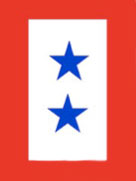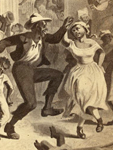Re-enactors
Gwen Wright of PBS's History Detectives looks at the popularity of historical reenactment and the particular appeal of Civil War reenactment.
Gwen Wright of PBS's History Detectives looks at the popularity of historical reenactment and the particular appeal of Civil War reenactment.
Wes Cowan of PBS's History Detectives discusses the work of photographers during the Civil War, including how photographers manipulated reality in constructing their shots.
The Custer Memorial consists of a bronze statue at the site of George Armstrong Custer's birth, the foundation of the house in which he was born, and an exhibit pavilion. George Custer (18391876), known as a daring cavalry brigade commander of the Civil War, and his division blocked General Robert E. Lee's retreat during the Appomattox Campaign. Post Civil War, within the army, Custer was defeated and killed in the Indian War's Battle of Little Bighorn (1876) by a Native American coalition (primarily Sioux, Cheyenne, and Arapaho) led by the Sioux Crazy Horse, Gall, and Sitting Bull.
The memorial offers an exhibit pavilion.
Named in honor of Henry Laurens, then president of the Continental Congress, Fort Laurens was built in 1778 in an ill-fated campaign to attack the British at Detroit. Supplying this wilderness outpost was its downfall, as its starving garrison survived on boiled moccasins and withstood a month-long siege by British-led Indians. The fort was abandoned in 1779. Today, only the outline of the fort remains, but a small museum commemorates the frontier soldier, presents a video giving the fort's history, and displays archaeological artifacts from the fort's excavation. The large park surrounding the museum is the location for periodic military reenactments. The remains of the soldiers who died defending the fort are buried in a crypt in the museum wall and at the Tomb of the Unknown Patriot of the American Revolution.
A second website covering the site, the Friends of Fort Laurens website, can be found here.
The site offers a short film; exhibits; and occasional recreational and educational events, including living history events.
Ulysses S. Grant was born 27 April 1822 in picturesque Point Pleasant near the mouth of Big Indian Creek at the Ohio River. This restored one-story, three-room cottage, which was built in 1817, was next to the tannery where Grant's father worked. The small cottage is furnished with period items. At one time the birthplace made an extensive tour of the United States on a railroad flatcar and was also temporarily displayed on the Ohio State fairgrounds.
The site offers tours.
Fort Jefferson Park and Monument mark the site of an advance outpost of General Arthur St. Clair, built in October 1791. It was named in honor of Thomas Jefferson, then Secretary of State. One of a chain of defensive forts built to protect army supplies from Indians, it served as a supply base throughout the campaigns of General St. Clair and General Anthony Wayne. It was abandoned in 1796. The monument is made of faced granite field boulders, six feet square and 20 feet tall. No part of the fort remains.
The site is open to the public.
The 7.4acre Battle of Carthage Historic Site preserves the location of the Battle of Carthage, one of the earliest engagements in the Civil War, fought 5 July, 1861. The site includes a portion of the battleground, as well as the site of both the Union and Confederate camps. The battle itself, a Confederate victory, was led by Union Colonel Franz Sigel and Confederate Governor Claiborne Jackson. In this skirmish, Sigel attempted to prevent Jackson's men from banding together with other nearby Confederate troops.
The site offers an informational kiosk.

Our church has a World War I service flag with 16 stars. One has a gold star. Two have gold crosses. What do the gold crosses mean?
Following America’s entrance into World War I, families of servicemen began displaying flags to show support for their sons and husbands fighting in France. According to the Blue Star Mothers of America Organization, the service flag was designed and patented by Army Captain Robert L. Queisser of the 5th Ohio Infantry, who had two sons serving in the war. (1)
Service flags were an indoor, wartime flag, generally about a foot in length and usually suspended vertically in a window for public viewing. Many of these flags were handmade from cotton or wool by mothers or spouses. Businesses and churches would sometimes display larger flags in order to recognize the service of employees or members. A blue star represented each family member in active service. In the event of a service member’s death, the blue star would either be covered or replaced with a gold star, sometimes surrounded by a laurel wreath. A gold circle signified distinguished service. Gold crosses set inside a blue star signified that a family member was wounded. A red star represented a captured or missing member. So it appears that your church’s service flag denoted 16 members serving in World War I, with one killed (gold star) and two wounded (gold crosses).
The display of service flags became extremely popular during World War II. One of the most well-known service flags served as a striking backdrop for a patriotic poster honoring the Sullivan brothers, all five of whom perished at sea with the sinking of the U.S.S. Juneau. Though the popularity of the service flag waned in the post-World War II years, it regained some of its popularity in the wake of 9/11 and the Iraq and Afghanistan conflicts, Today, the Department of Defense has specific regulations for manufacturing, selling, and displaying the service flag. For example, vendors must obtain a license to manufacture the flag; its ratio of length to width must be the same as the national flag, and display of the service flag at a residence is restricted to immediate family members and only during wartime.
Kerrick, Harrison S. The Flag of the United States: Your Flag and Mine. Columbus, OH: Champlin Publishing Company, 1925.
Institute of Heraldry, Office of the Administrative Assistant to the Secretary of the Army. “Frequently Asked Questions-Service Flag and Service Lapel Button.” Accessed August 21, 2012.

Are you ready for September 17? The National Endowment for the Humanities (NEH) is. This year, the NEH will celebrate Constitution Day by honoring the Constitution together with another pivotal document from U.S. history: the Emancipation Proclamation. With the Proclamation's 150th anniversary approaching, Constitution Day is the perfect time to compare and contrast the promises made in the Constitution and the Emancipation Proclamation.
From the NEH's Emancipation Resource Portal, you can access resources and learn more about planned events. Highlights include:
For more on the Emancipation Proclamation, check out materials highlighted here on Teachinghistory.org. Watch 8th-grade teacher Jason Fitzgerald introduce his students to the Proclamation using letters from Civil War soldiers. (Download the letters here as you listen to historian Chandra Manning analyze their contents.)
Or join historian John Buescher in this Ask a Historian as he considers what makes a document a founding document. Is it a document that stands for part of what the U.S. represents? A document from the country's founding?
As your students prepare for Constitution Day, the NEH's theme gives you the perfect chance to ask, "In what ways are the Constitution and the Emancipation Proclamation both founding documents?" Analyzing them together gives students a unique opportunity to explore the changing definition of "We the People."
According to The Library of Congress Webcasts site:
"Historiography on U.S.-Cuban relations has tended to cast an aura of inevitability on Fidel Castro's Revolution—as well as on Cuba's clash with the United States after 1959. Indeed, much of the historiography suggests that it was Washington's hegemonic approach to Cuba that was responsible for creating the structural disequilibrium that made revolution and the rupture of bilateral relationships inevitable. In this talk, Vanni Pettina argues against this view, maintaining that the US-Cuban relationship during the 1930s and '40s was marked by a reciprocal cooperative attitude that favored the island's democratic consolidation and economic development. The tremendous impact of the Cold War on US-Cuban relations played a crucial role in destroying the equilibrium of earlier decades, destabilizing the island's political system, and creating fertile ground for the crisis of the 1950s."